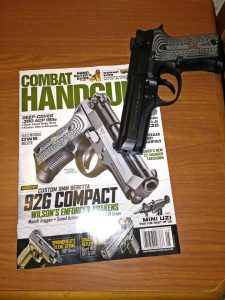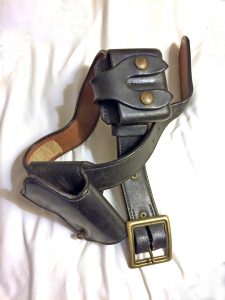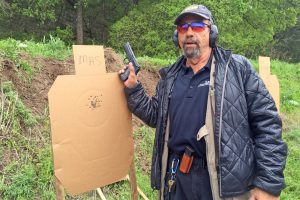A few days ago, I was passing through the Panhandle of Florida and got to spend dinner with a guy I hadn’t seen in 30 or so years, and whom I first met 40 years ago.
I had met “Johnny” Robbins when he was tagging along with his dad Jack Robbins at the first “big money professional pistol match,” the National Shooting League event sponsored by Dr. Bob Burgess in 1976 in Laramie, Wyoming. The following year, we met again at the Second Chance Shoot in Central Lake, Michigan.
Johnny outshot his dad at that match. And me. And everybody else. He set a record time to come up off a shooting bench on a start signal and stop the timer when the last of five bowling pins were blown off a table 25 feet away.
Johnny was thirteen years old at the time.
You can read about it here: http://americanhandgunner.com/1978issues/HSO78.pdf .
Johnny and Jack hit the Second Chance Shoot every year after, and when the Bianchi Cup came along, they shot that too. That came to an end in the mid-1980s when Jack, who had never smoked a cigarette in his life, died of lung cancer at 47. Johnny came to Second Chance by himself the year after that, but it wasn’t quite the same, and…he stopped going.
Jack Robbins, you have to understand, worked at Eglin Air Force Base and was the prime mover in the legendary JSSAP (Joint Services Small Arms Project) tests that led to the adoption of the Beretta M9 pistol all-service-wide by the United States military at about the time Jack passed.
As John and I reminisced (while all the shooters called the kid “Johnny,” his father Jack called him John, which is what he has gone by ever since), he remembered that when Jack told Smith & Wesson officials why their guns of the period were failing in the tests, they ignored him, but when Jack told Beretta officials what they’d have to change to pass the tests, they listened. That link from the 1978 issue of American Handgunner has a picture of Beretta’s 9mm circa that period. Compare that to the M9 of today. You can see Beretta listened. A fuller account is in my book “Gun Digest Book of Beretta Pistols.”
John Robbins is 52 now, a proud dad and grand-dad himself. Still a shooter, just out of competition for all these years; it was something he shared with his dad, and when Jack passed, it lost meaning. (Gonna try to get him to shoot a match with me now, though.) Retired from a career as a firefighter/paramedic, John is now a paramedic working with a Florida hospital. He’s carrying on his father’s tradition of taking care of others.
Before we parted, John presented me with his dad’s Milt Sparks custom holster/belt/magazine pouch set for the 1911 .45 he preferred to compete with. “My dad was right-handed like you, I’m left-handed, and besides, he’d have wanted you to have it,” he said. It’s going to occupy a place of honor in my library/gun room.
Read that old article. Please. It will show you how a fine man raised a fine son with guns. For Jack, the guns – like other icons of adult responsibility – were tools of parenting.
Wherever you are, Jack, know that a lot of us still miss you, and it was great to re-connect with your son. You’d still be as proud of him as you were when he was younger…and I just want you to know, I was glad I was carrying a Wilson Combat Beretta 92G when we met again. Without Jack Robbins, I’m not sure that fine pistol would still be in production, and the iconic American protection weapon it is today.
John and Mas today.
Without John’s dad Jack, I don’t think we’d have today’s cool Berettas like this one, from Wilson Combat.
Jack Robbins’ old Milt Sparks 1911 rig will occupy a place of honor.
Today’s 60-shot pace-setter target, shot in Texas, is dedicated to the memory of Jack Robbins, who did so much to re-design the modern Beretta that was used.







Precious memories. Very nice update. Loved reading the blog post and the article from way back. Was delighted to have the whole issue and not merely one article. Couldn’t help noticing the one of a kind ‘Rare Gun’ on the page just ahead of where the Robbins story continued. Thought maybe it was an April Fools edition. Siamese twins? Ha ha ha!
Jack Robbins was also Project Manager for the Colt IMP. The IMP was developed from Dale Davis’ “arm gun” design for a compact aircrew survival weapon. Davis reportedly licensed his patent to Mack Gwinn for what became the Bushmaster pistol.
In addition, Robbins and Davis were responsible for the truncated cone projectile design that Hornady/Frontier later marketed in 9mm and .45 ACP. This was covered by US Patent #4,517,898.
Good points, Mr. Watters, and welcome to the blog. I’ve enjoyed your work for many years.
Damn. How can I shoot a pace setter like that Mas?
It was great to see you again Mass! I am currently sorting thru my stuff, we need to shoot The Cup again.
Mr Watters, did you know my father?
Eddie, I just practice what I preach. Power stance, high hand grasp, crush grip, front sight focus, and smooth roll of the trigger. Fire every shot as if it was the one chance you had to make a rescue shot and save a life.
As my friend and mentor the late, great Ray Chapman used to say, “It’s simple…it just isn’t easy.”
So that would have been 1977. Yep, I was there and saw the kid shoot. Couldn’t remember the year though. When it got around that his dad was an Air Force officer we figured he probably got all the free ammo he could shoot. I too used the Second Chance cardboard targets. Only, I had to use hand made wax bullets in a revolver in my basement for practice.
Once again we are treated to some top notch stuff.
Thanks too, for the link. Lovely to read this one from waay back there in ’78!
Great story and thanks for the link to the old issue. I was amused to find another jewel in that edition under the “Speak Out” area where a retired agent brashly suggested that the federal agencies might be better served by moving to a 40 caliber weapon; this was 8 years before the Miami shoot-out that set the FBI down that exact path. There is so much to appreciate in what was written back in the day, before most of us realized its ultimate significance.
Mr. Robbins,
I’m afraid that I never had the chance to meet your father or Dale Davis. I only know them via their reputation.
It’s nice to meet you Mr. Watters, I have lost track of my fathers friends for the most part. I can take pictures of the IMP prototype if anyone is interested.
Very thoughtful story as usual Mas. I also like the link to the ’78 Handgunner Issue. I was particularly intrigued by the Colonel’s column and his comment the the 9×19 parabellum “should be replaced by the ordinance departments of the free world.” Would that we could all peer into the crystal ball and foresee the future technological advancements awaiting us. I wonder if he would think the same if he were alive today?
That rig does deserve a place of honor but, I have to ask is the other reason that you won’t wear it due waist size conflict-LOL. Most dads who are firearm savy want their sons to grow up like Jack Robbins’ boy, John-a fine young man,
Mas, I really enjoy these type articles and stories, where newer guys to the discipline, like myself get a little history lesson and vicariously meet some of the great men from our past. Thanks for all you do!
Those were the good old days. I remember seeing ‘The Kid’ and his dad up in Central Lake during a few of Rich Davis’ parties and had spoken to Jack briefly about his work on the military pistol program. I remembered he was in the USAF at the time, circa 1982. Johnny was and probably still is the youngest Master Blaster ever at Second Chance in his early teens, around the same age as Davis’ two sons. I was lucky enough to get up to Central Lake four times, 1980-82 and again in 1987 or 1988. I miss those good times. Glad to hear John is doing well and is now a grandfather. Gasp!
Thank you for sharing that story.
Comments are closed.